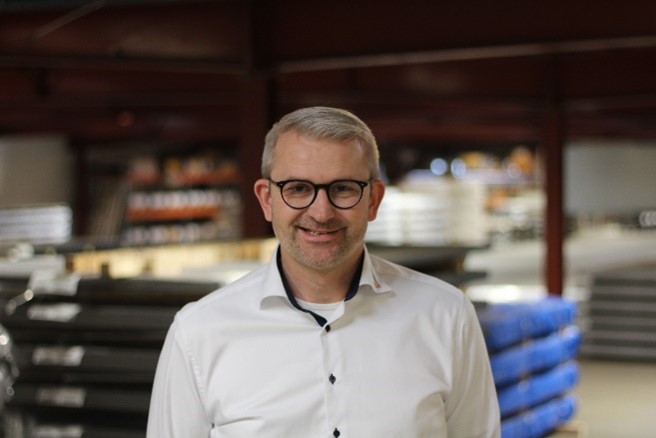Give Steel supplies structural steel with an average CO2 footprint as low as 542 kg per tonne of prepainted structural steel (product stage A1-A3), to ambitious builders who are expanding their production facilities. The raw material for the steel structure with the low-carbon emissions steel goes by the name XCarb® recycled and renewably produced and has recently found its way to several of their projects through a close collaboration between Give Steel and the steel wholesaler Lemvigh-Müller, which sources the steel from ArcelorMittal, the world’s leading steel and mining company. Strict documentation requirements have placed great demands on close dialogue and cooperation between the client, supplier, and the steel mill regarding the documentation of the raw material and delivery times.
As highlighted by Lars Dalgas, purchasing manager of Give Steel: “The project’s large beams in XCarb® recycled and renewably produced steel, with 333 kg of CO2 per tonne, have one of the market’s lowest CO2 footprints within its category and in the desired dimensions. It is approximately one third of the CO2 footprint of the average raw material, which today forms the basis of Give Steel’s EPD, which reads 1,050 kg CO2 per tonne for general structural steel.”
For one of the projects using XCarb® recycled and renewably produced steel, Give Steel supplies approx. 6500 tonnes of structural steel, of which 80-90% of the raw material is expected to be XCarb® recycled and renewably produced steel.
Early involvement essential
In Give Steel’s purchasing department, they emphasize the importance of close cooperation and early involvement when, as a contractor and client, you want to reduce the CO2 footprint of your steel construction.
“We have been involved early in the process and have thus been given the opportunity to incorporate CO2 savings into the steel construction from the start, by laying out a plan for selecting steel mills with the lowest CO2 figures” says Lars Dalgas, purchasing manager at Give Steel.
In Give Steel, we collaborate with all our suppliers to identify raw materials and obtain CO2 documentation. XCarb® recycled and renewably produced achieves its low CO2 value because it consists almost entirely of recycled steel scrap and is primarily produced with 100% renewable electricity.
Increasing demand for CO2 reduced steel
Give Steel generally experiences increased demand for low-carbon emissions steel from climate-conscious builders. Everything is on schedule for the company, which recently committed to the Science-Based Target initiative (SBTi). In this way, Give Steel ensures that the company’s climate objectives are evidence-based and in accordance with the Paris Agreement. The increasing demand for low-carbon steel thus plays a significant role for Give Steel’s climate strategy, as both short- and long-term goals must ensure that the global temperature rise does not exceed 1.5 degrees. Furthermore, Give Steel’s operations must be CO2 neutral by 2050.
The steel industry is generally responsible for approximately 5% of Europe’s total CO2 emissions. Thus, there is a strong imperative for the steel industry to undergo a green transition. Fortunately, at the steel wholesaler Lemvigh-Müller, you can see that most steel mills are highly motivated to reduce CO2 emissions and are making substantial investments to achieve this goal.
Martin Jagd Nielsen, the Department Head at Stål, Lemvigh-Müller, emphasizes the increasing significance of sustainability in their partnership with Give Steel A/S in recent years. This pertains not only to discussions about raw materials but also to consultations about documentation requirements.
He says: “In a specific case involving the establishment of new factories for a prominent Danish production company, there was a continuous dialogue with Give Steel regarding CO2 limitations right from the project’s inception. Several entities are actively engaged in minimizing their GWP (Global Warming Potential) figures for their products. For this specific case, the necessity for large beams and HD beams dictated a limited number of suppliers capable of providing these dimensions. Also, stringent documentation requirements substantially narrowed down the selection. Therefore, we went ahead to proceed with ArcelorMittal and their XCarb® recycled and renewably produced steel.”
Martin further elaborates: “It has been a long process that lasted several months. There was immense gratification when, in collaboration with Give Steel A/S, the initial order for large beams made of XCarb® recycled and renewably produced steel happened at the beginning of May. Throughout this process, we provided continuous assistance and addressed numerous questions regarding raw materials, documentation, and delivery schedules. A close-knit dialogue was maintained with Give Steel A/S and ArcelorMittal to prioritize and optimally resolve the task.”
Furthermore, Lemvigh-Müller has an ESG department with three employees dedicated to ensuring compliance, training internal employees, and knowledge sharing with customers. For a long time, Lemvigh-Müller has engaged in productive collaboration with Give Steel concerning the increasing demands, leveraging the combined knowledge of both companies during the process.
Development at the works
Regarding advancements in the industry, Martin remarks, “Most manufacturers are actively involved in preparations or implementation for the transition towards sustainable practices. Recently, we’ve been presented with enhanced EPDs from our key suppliers, including those providing beams. Most beam mills in Europe operate based on scrap material, which undergoes a remelting process in electric arc furnaces (EAFs) to produce steel. Although this process demands significant energy, it’s a less environmentally harmful production method compared to ore-based facilities. Scrap-based plants can substantially reduce CO2 emissions through conversion and the use of renewable energy sources. Consequently, the sections mills have been able to decrease CO2 emissions from over 1,000 CO2-e/tonne to 333 CO2-e/tonne for sections.”
In conclusion, Martin says: “Most steel mills exhibit a strong commitment to reducing CO2 emissions. They are acutely aware of their role in contributing approximately 5% of Europe’s total CO2 emissions. Consequently, they are making substantial investments to further reduce these emissions, and many aspire to become CO2 neutral.”

